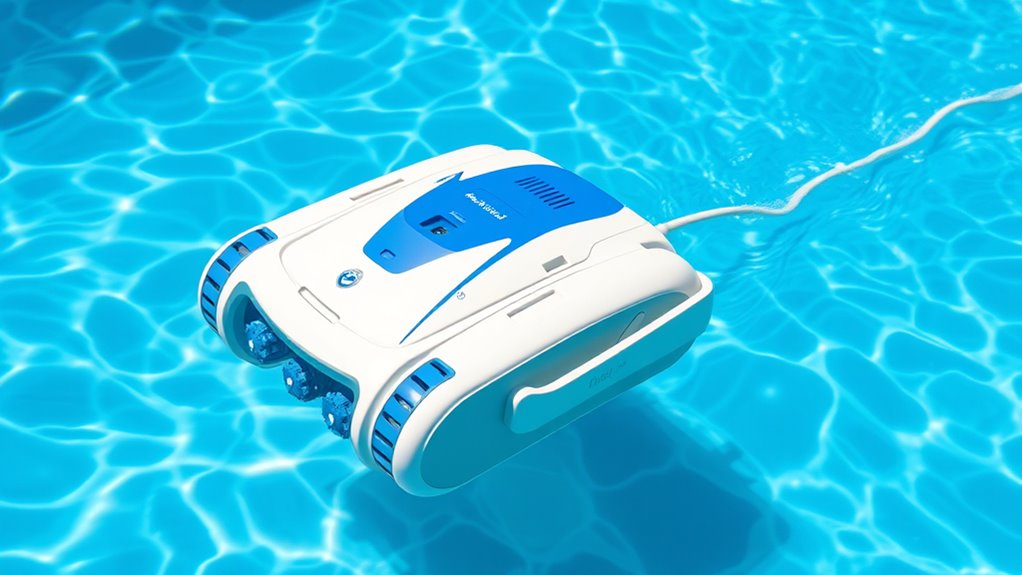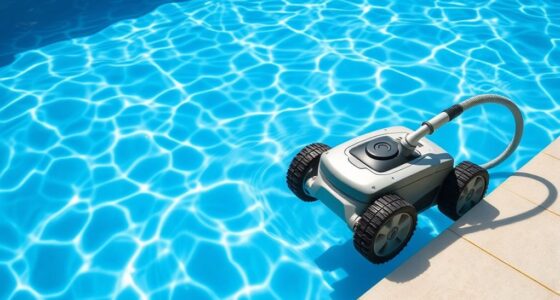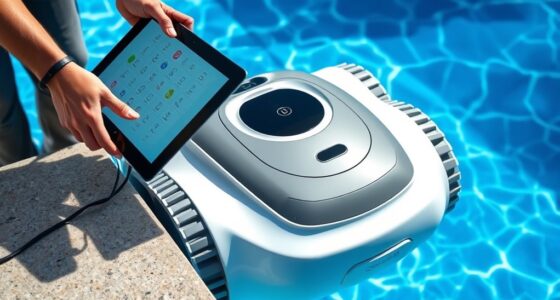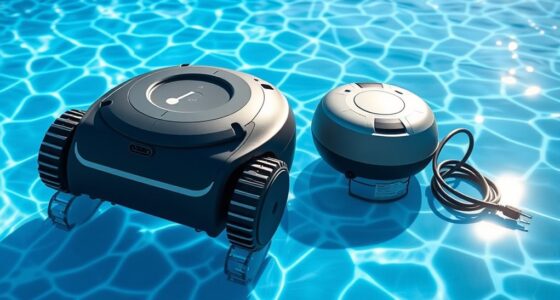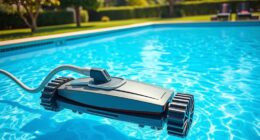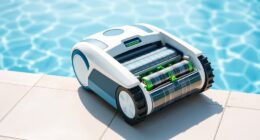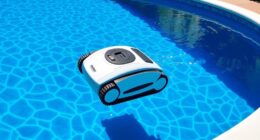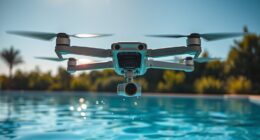Robotic pool cleaners work by using motors, sensors, and advanced algorithms to navigate your pool automatically. They move around, avoiding obstacles and mapping the area to cover all surfaces efficiently. Their cleaning mechanisms, like brushes and filters, pick up debris, while sensors help prevent missed spots. Powered by rechargeable batteries, they return to charging stations when needed. Want to know more about how these smart devices make pool cleaning effortless? Keep exploring!
Key Takeaways
- They use motors to propel movement and operate cleaning mechanisms like brushes and vacuums.
- Sensors detect obstacles and pool features, enabling navigation and route adjustments.
- Advanced algorithms and mapping techniques plan systematic or random cleaning paths.
- Batteries power the device, with automatic docking stations for charging and extended operation.
- Control systems allow scheduling, mode selection, and real-time adjustments for efficient cleaning.
Components of a Robotic Pool Cleaner
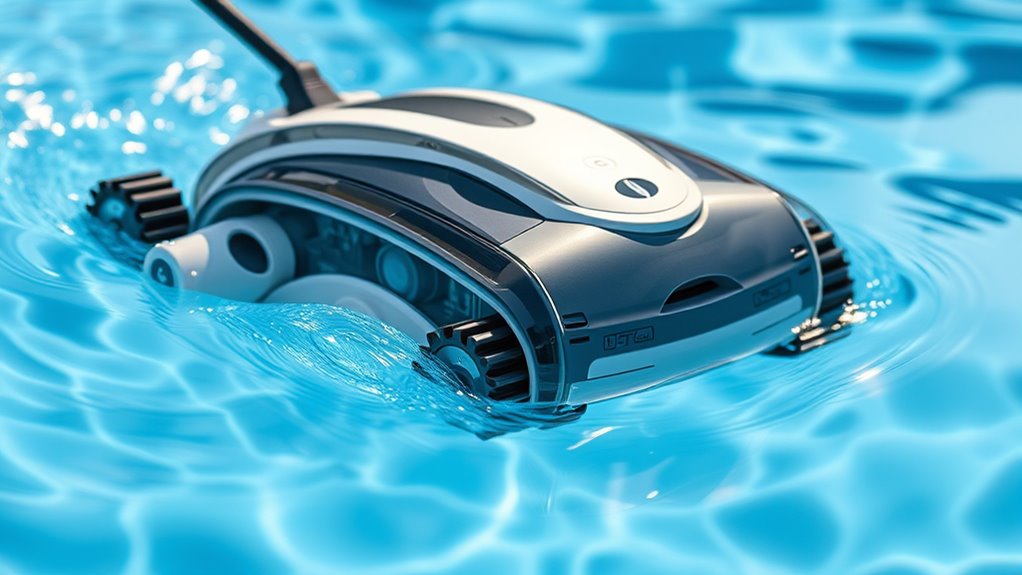
What are the essential parts that make a robotic pool cleaner work effectively? First, it needs a reliable motor that powers its movement and cleaning functions. The filter system is crucial for trapping debris, and it often includes fine filters for dirt and larger baskets for leaves. The electronic control board manages the cleaner’s operations, ensuring efficient movement and cleaning cycles. Sensors help detect obstacles and adjust routes accordingly. Additionally, the power supply or cable ensures consistent energy flow. Vetted components, such as high-quality motors and filters, contribute significantly to the cleaner’s performance and durability. While the robotic cleaner operates independently, considering factors like pool water temperature and pool chemical balance is vital. Proper chemical balance prevents corrosion and maintains the integrity of the device’s components, ensuring it runs smoothly and lasts longer. Incorporating advanced navigation sensors can further improve cleaning efficiency and coverage. Moreover, integrating efficient power management systems can extend the cleaner’s operational lifespan and reduce energy consumption.
How Robotic Pool Cleaners Move Around the Pool
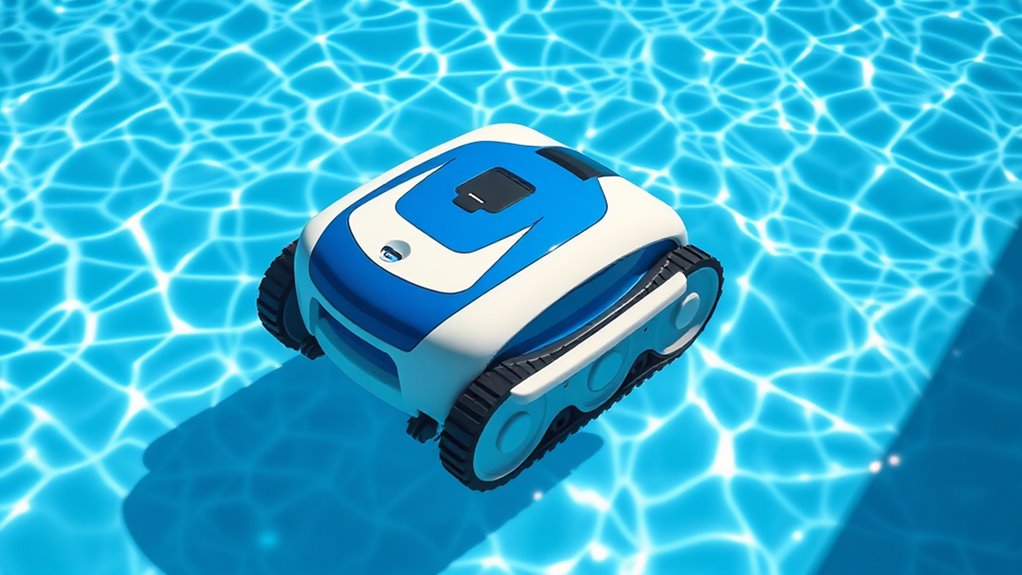
Robotic pool cleaners navigate the pool environment using a variety of movement methods designed to maximize coverage and efficiency. They move across the pool surface and floor, using algorithms and sensors to determine the best path. Some models use random patterns, which guarantee all areas are eventually cleaned, while others follow systematic routes for faster coverage. As they traverse the pool, they adjust their direction to avoid obstacles and reach hard-to-access spots. Their precise movements help loosen dirt and debris, making debris collection more effective. With sensors monitoring their position, robotic cleaners can adapt to different pool shapes and sizes, ensuring thorough cleaning without missing spots. This intelligent movement maximizes debris collection while minimizing cleaning time. Additionally, movement algorithms enable these devices to optimize their cleaning paths, further enhancing efficiency and coverage. Moreover, these robots often utilize navigation sensors to map the pool environment, allowing for more strategic cleaning routes tailored to each pool’s unique layout.
The Cleaning Mechanisms at Work
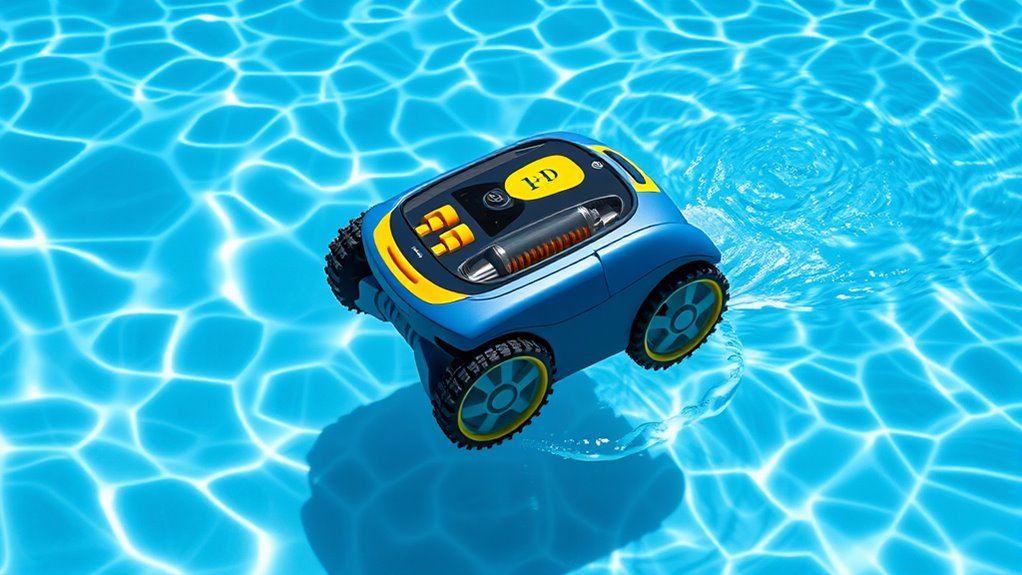
Robotic pool cleaners rely on a combination of brushes, vacuums, and filters to effectively remove dirt and debris from your pool. They use different filter types, like cartridge, sand, or diatomaceous earth, to trap particles. The cleaning patterns vary depending on the model, with some following systematic paths and others using random movement. These patterns ensure thorough coverage, minimizing missed spots. Additionally, many models incorporate textile line technology to enhance their cleaning efficiency. Incorporating personal development techniques like goal setting and mindfulness can also improve your overall pool maintenance routine. Regular maintenance and understanding the working mechanisms can extend the lifespan and performance of your robotic cleaner, especially as automation in business continues to advance and influence technology.
Navigation and Path Planning Technology
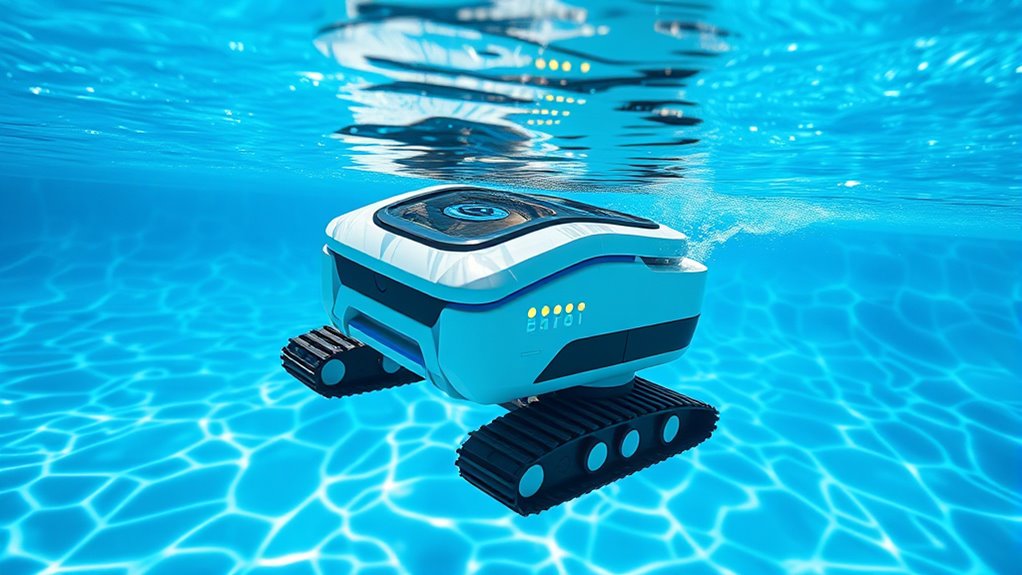
Navigation and path planning technology enable robotic pool cleaners to efficiently cover the entire pool surface. When you set your cleaning schedule, these systems analyze your pool size to determine the most effective route. Larger pools may require more complex algorithms to guarantee thorough cleaning without missing spots. It also incorporates precise mapping techniques to enhance navigation accuracy. The robot uses sensors and mapping techniques to navigate around obstacles, walls, and corners, adapting its path as needed. It avoids unnecessary repetitions and ensures extensive coverage, saving you time and effort. Advanced navigation helps the cleaner optimize its route, especially in pools with irregular shapes or obstacles. This technology guarantees consistent cleaning schedules, so your pool stays spotless without you needing to monitor or intervene constantly. Incorporating leadership skills in its programming can improve the robot’s ability to adapt to various pool environments efficiently. Additionally, ongoing advancements in navigation algorithms continue to improve the efficiency and reliability of robotic pool cleaners. Furthermore, these systems often utilize real-time data processing to make immediate adjustments during cleaning sessions.
Power Source and Battery Life
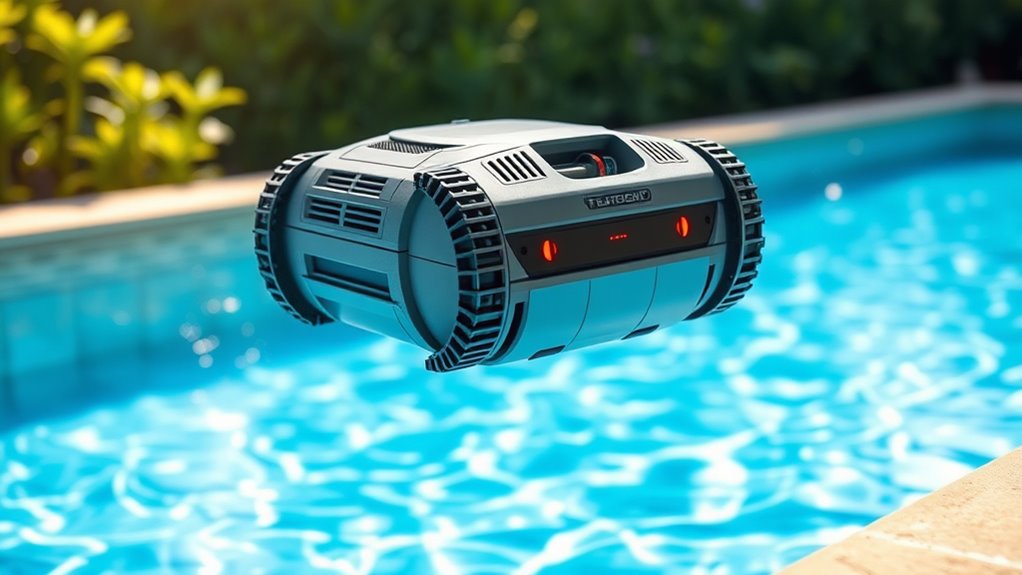
Your robotic pool cleaner’s battery type and its runtime are key to keeping your pool spotless without interruptions. Charging mechanisms vary, with some models offering quick or automatic charging options for convenience. Look for power efficiency features that extend battery life and optimize cleaning time. Incorporating energy-efficient components can further enhance overall performance and battery longevity. Additionally, choosing models with smart power management can help conserve energy during operation and extend the lifespan of your device. Regular maintenance of the battery system ensures optimal performance and prevents unexpected downtime. Monitoring battery health regularly can help identify potential issues early and prolong the overall lifespan of your cleaner. Being aware of battery specifications can also assist in selecting the most suitable model for your needs.
Battery Types and Duration
Battery types and their durations play a crucial role in the performance of robotic pool cleaners. Longer-lasting batteries let you clean more efficiently without frequent interruptions, promoting pool safety and reducing accidental mishaps. Many models now use eco-friendly materials in their batteries, helping you maintain a greener environment. The table below compares common battery types:
| Battery Type | Average Duration | Key Feature |
|---|---|---|
| Lithium-ion | 1.5-2 hours | Lightweight, fast charging |
| Nickel-metal hydride | 1-1.5 hours | Cost-effective, durable |
| Lead-acid | 0.5-1 hour | Heavy, less eco friendly |
Choosing the right battery ensures your cleaner operates longer, saving time and energy while keeping your pool safe and eco-friendly. Optimal battery performance can significantly enhance the overall effectiveness of your robotic pool cleaner. Additionally, battery maintenance can extend the lifespan and efficiency of your power source, which is essential for maintaining optimal performance. Proper care and regular checks can also help prevent battery degradation, ensuring consistent operation over time.
Charging Mechanisms Used
Charging mechanisms are essential to guaranteeing robotic pool cleaners operate efficiently and reliably. Most models use charging stations where the robot docks to recharge, often with precision alignment. Some advanced cleaners utilize wireless power, eliminating the need for physical connections. Picture these scenarios:
- You watch as the cleaner smoothly glides into the station, aligning perfectly on its own.
- You notice a sleek device hovering over a pad, wirelessly charging without cords.
- You see the battery indicator steady, ready for the next pool cleaning session.
- Regular maintenance of battery life and ensuring proper charging practices help extend the lifespan of your robotic cleaner. Additionally, advancements in power transfer technology are making wireless charging more efficient and widespread, improving overall energy efficiency of these devices.
These mechanisms ensure your robot stays powered longer and reduces downtime. Whether through traditional charging stations or innovative wireless power, reliable charging is key to maintaining consistent cleaning performance in your pool.
Power Efficiency Features
Modern robotic pool cleaners are designed to maximize power efficiency, ensuring longer cleaning sessions and minimizing downtime. They use energy conservation techniques to extend battery life and reduce overall power consumption. Many models feature eco-friendly designs, incorporating low-power motors and smart power management systems that optimize energy use during operation. These innovations allow your cleaner to run longer on a single charge, making the cleaning process more efficient and environmentally friendly. Some cleaners also automatically return to their charging stations when power is low, further conserving energy. By focusing on power efficiency features like advanced batteries and energy-saving components, these cleaners help you save on electricity costs while supporting eco-conscious pool maintenance.
Control Systems and Programming Features
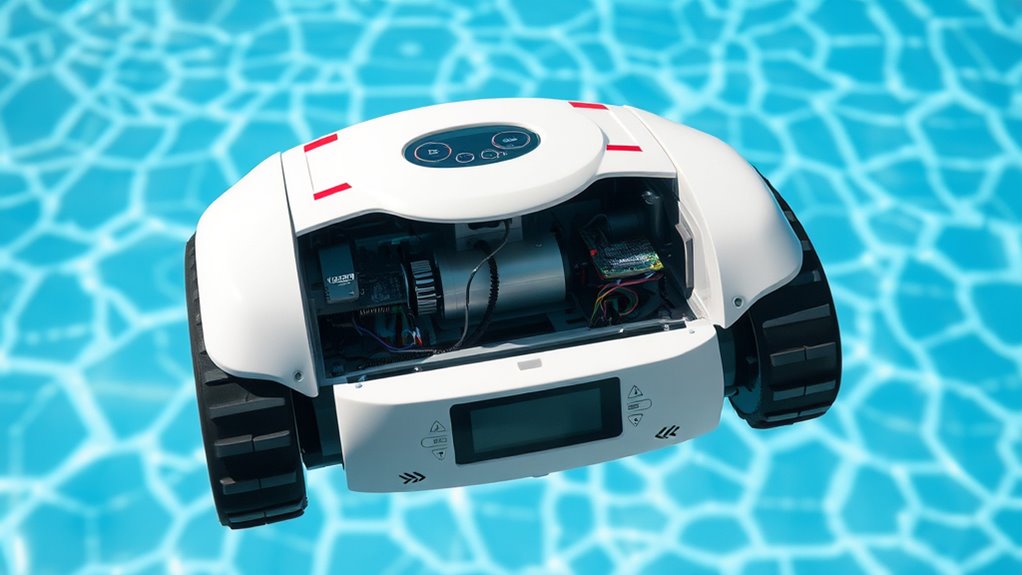
Control systems and programming features are at the heart of what makes robotic pool cleaners efficient and user-friendly. They rely on advanced programming algorithms and intuitive control interfaces to navigate your pool effectively. Imagine:
- A control interface that allows you to select cleaning modes or schedule sessions with a tap.
- Programming algorithms that guide the cleaner to cover every inch of the pool systematically.
- Sensors that communicate with the control system, adjusting the cleaner’s path in real-time.
These features work together to optimize cleaning, reduce missed spots, and prevent tangling. The user-friendly control interfaces make it easy to customize cleaning routines, while the programming algorithms ensure thorough coverage. Overall, these systems make your pool cleaning effortless and efficient.
Advantages of Using Robotic Pool Cleaners
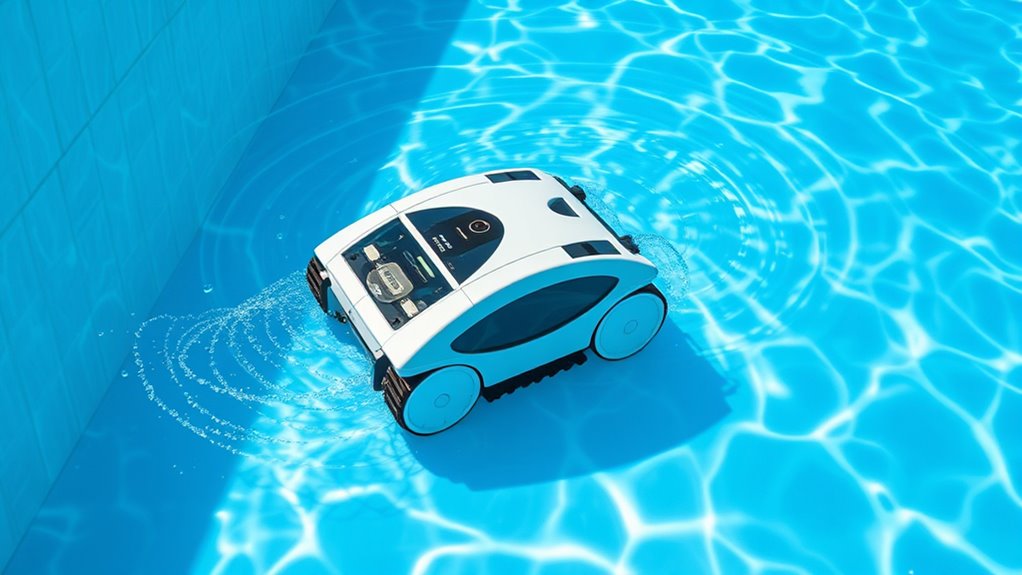
Using robotic pool cleaners offers numerous advantages that make pool maintenance simpler and more efficient. They adapt easily to different pool sizes, guaranteeing thorough cleaning regardless of the pool’s dimensions. You don’t need to worry about manually scrubbing every corner or adjusting cleaning schedules constantly—these cleaners work automatically, saving you time and effort. Plus, they allow you to customize cleaning based on your preferences, whether you want a quick skim or a deep clean. Robotic cleaners are energy-efficient, often using less power than traditional methods, and require minimal supervision. Their advanced navigation systems ensure extensive coverage, reducing the risk of missed spots. Overall, robotic pool cleaners give you more control, convenience, and peace of mind when maintaining your pool.
Maintenance and Troubleshooting Tips
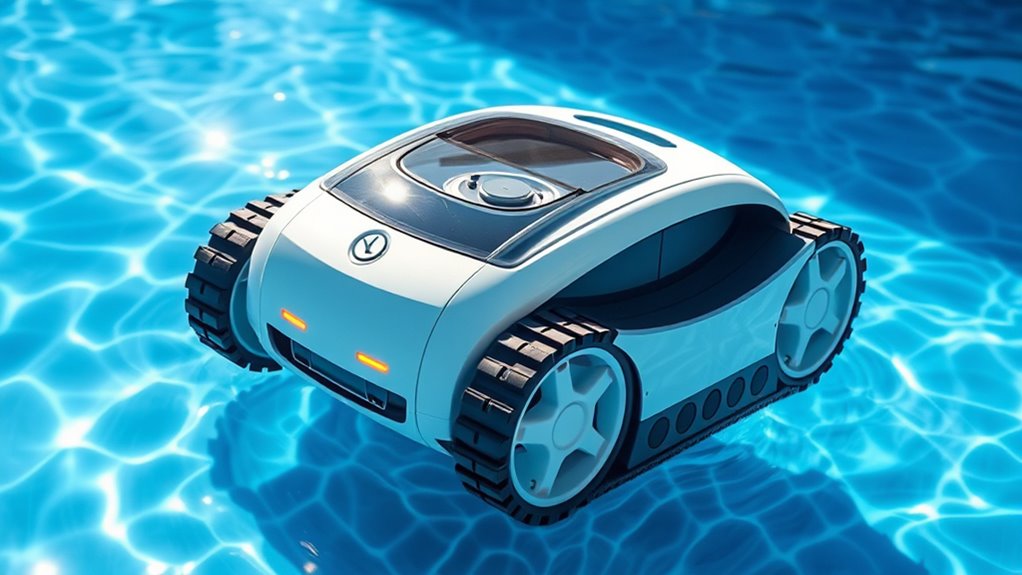
Regular maintenance is essential to keep your robotic pool cleaner functioning effectively. To prevent breakdowns, check the filter regularly and perform filter maintenance by removing debris and rinsing it thoroughly. This guarantees optimal suction and cleaning performance. Additionally, sensor calibration is vital; if your cleaner isn’t steering correctly, recalibrate the sensors following the manufacturer’s instructions. Here’s what you should do:
- Remove and inspect the filter, cleaning out dirt and obstructions.
- Rinse the filter with water to prevent clogging.
- Calibrate sensors periodically to maintain accurate navigation.
Frequently Asked Questions
Can Robotic Pool Cleaners Handle Different Pool Shapes and Sizes?
Robotic pool cleaners excel in handling various pool shapes and sizes, thanks to their advanced design features. You’ll find that most models offer excellent pool shape compatibility, maneuvering smoothly around corners and curves. Their size adaptability allows them to clean efficiently in small, medium, or large pools. Just guarantee you select a model suited for your specific pool dimensions and shape, and you’ll enjoy a sparkling clean pool effortlessly.
How Do Robotic Cleaners Detect and Avoid Obstacles?
You might think obstacle detection is too complex, but robotic pool cleaners use sensor navigation to make it simple. Ironically, they’re smarter than you’d expect, constantly scanning their surroundings with advanced sensors. When they spot an obstacle, they adjust course automatically, avoiding bumps and scratches. Thanks to obstacle detection, these cleaners glide smoothly around your pool, ensuring a thorough clean without you having to lift a finger.
Are Robotic Pool Cleaners Safe for All Pool Types?
You’ll find that robotic pool cleaners are generally safe for most pool types, but you should verify their pool chemical compatibility first. They handle dirt and debris well, reducing your manual cleaning necessity. However, some models may not work as effectively in certain pool surfaces or with specific chemicals. Always follow manufacturer instructions to guarantee safe operation, and consider manual cleaning for stubborn stains or delicate surfaces.
What Is the Typical Lifespan of a Robotic Pool Cleaner?
Did you know the average robotic pool cleaner lasts about 3 to 5 years? To maximize its lifespan, you should follow simple maintenance tips like regular cleaning and checking the brushes. Keep an eye on the battery life, as it typically diminishes over time. Proper care guarantees your cleaner works efficiently, saving you money and hassle in the long run. With good maintenance, your device can stay in great shape for years.
Do Robotic Pool Cleaners Require Wi-Fi or Internet Connectivity?
Robotic pool cleaners don’t always require Wi-Fi connectivity or internet requirements to operate. Most models work independently, steering your pool using built-in sensors and algorithms. However, some advanced cleaners offer Wi-Fi connectivity, allowing you to control and schedule cleaning sessions via a smartphone app. If you prefer remote control options or customized settings, choosing a model with Wi-Fi connectivity is beneficial. Otherwise, basic models function well without internet access.
Conclusion
Now that you know how robotic pool cleaners work, it’s clear they’re like tiny underwater robots on a mission, weaving through your pool with precision. Their advanced navigation, powerful cleaning mechanisms, and smart programming make pool maintenance feel effortless. With proper care, these machines become your pool’s best friend, keeping it sparkling clean like a well-choreographed dance. Embrace technology’s touch, and watch your pool shine brighter than ever.
